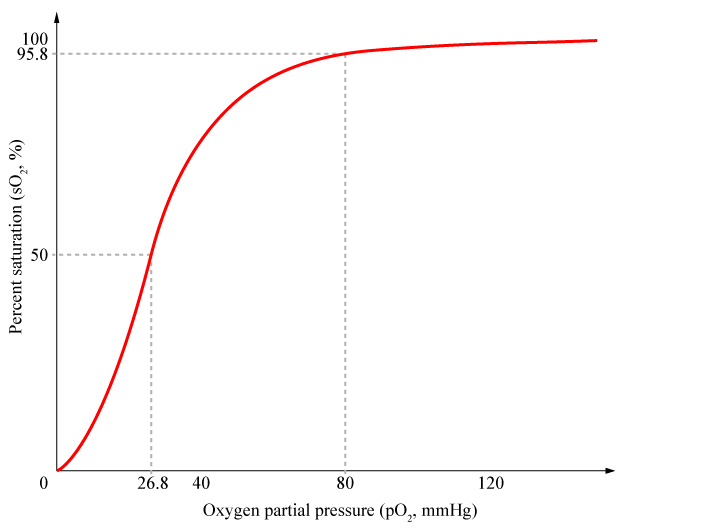
The Sigmoid shape of dissociation curve is because
A. Binding oxygen to haemoglobin. As the first oxygen molecule binds to haemoglobin, it increases the affinity for the second molecule of oxygen to bind. Subsequently, haemoglobin attracts more oxygen.
B. The curve shows equilibrium of oxyhaemoglobin and haemoglobin.
C. In the lungs the partial pressure of oxygen is high.
D. Tissues have a low oxygen concentration.
Answer
486.3k+ views
1 likes
Hint: The oxyhaemoglobin dissociation curve explains the relation between the partial pressure and the oxygen saturation. As the oxygen molecule binds with the haemoglobin, its affinity for oxygen increases per binding.
Complete Answer:
- In the dissociation curve, the partial pressure of oxygen is taken on the X-axis and the oxygen saturation is taken on the y-axis. It helps us in understanding how our blood carries and releases oxygen. It determines the oxygen affinity of haemoglobin.
- The standard dissociation curve is sigmoid shape or S-shaped. This is due to the haemoglobin. The haemoglobin travels from the lungs to the tissues due to which the partial pressure becomes high.
- The surrounding pH value decreases and the amount of

Thus the correct answer is (A).
Note: Several factors affect the affinity of haemoglobin to oxygen which affects the oxygen-haemoglobin dissociation curve.
- pH
- Temperature
- Carbon dioxide
- Carbon monoxide
Complete Answer:
- In the dissociation curve, the partial pressure of oxygen is taken on the X-axis and the oxygen saturation is taken on the y-axis. It helps us in understanding how our blood carries and releases oxygen. It determines the oxygen affinity of haemoglobin.
- The standard dissociation curve is sigmoid shape or S-shaped. This is due to the haemoglobin. The haemoglobin travels from the lungs to the tissues due to which the partial pressure becomes high.
- The surrounding pH value decreases and the amount of

Thus the correct answer is (A).
Note: Several factors affect the affinity of haemoglobin to oxygen which affects the oxygen-haemoglobin dissociation curve.
- pH
- Temperature
- Carbon dioxide
- Carbon monoxide
Latest Vedantu courses for you
Grade 10 | CBSE | SCHOOL | English
Vedantu 10 CBSE Pro Course - (2025-26)
School Full course for CBSE students
₹37,300 per year
Recently Updated Pages
Master Class 9 General Knowledge: Engaging Questions & Answers for Success

Master Class 9 English: Engaging Questions & Answers for Success

Master Class 9 Science: Engaging Questions & Answers for Success

Master Class 9 Social Science: Engaging Questions & Answers for Success

Master Class 9 Maths: Engaging Questions & Answers for Success

Class 9 Question and Answer - Your Ultimate Solutions Guide

Trending doubts
State and prove Bernoullis theorem class 11 physics CBSE

What are Quantum numbers Explain the quantum number class 11 chemistry CBSE

Who built the Grand Trunk Road AChandragupta Maurya class 11 social science CBSE

1 ton equals to A 100 kg B 1000 kg C 10 kg D 10000 class 11 physics CBSE

State the laws of reflection of light

One Metric ton is equal to kg A 10000 B 1000 C 100 class 11 physics CBSE




